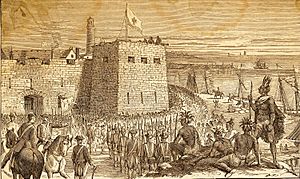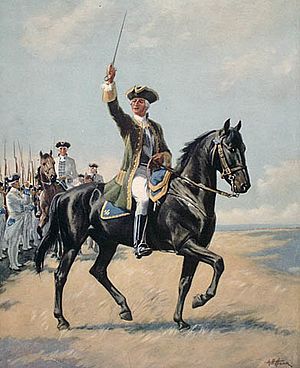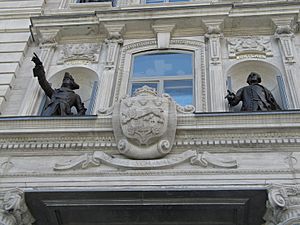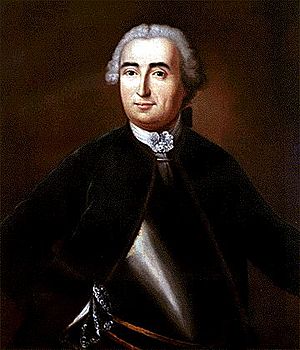Louis-Joseph de Montcalm facts for kids
Quick facts for kids
Montcalm
|
|
|---|---|

Portrait by Antoine-François Sergent-Marceau
|
|
| Born | Chateau de Candiac, near Nîmes, France |
| Died | 14 September 1759 (aged 47) Plains of Abraham, Quebec City, Quebec (then New France) |
| Buried |
Plains of Abraham, Quebec City, Quebec
|
| Allegiance | |
| Service/ |
|
| Years of service | 1721–1759 |
| Rank | Lieutenant General |
| Commands held | Regiment d'Auxerrois Regiment de Montcalm Commander-in-chief, New France |
| Battles/wars |
|
| Awards | Order of Saint Louis |
| Spouse(s) | Angelique Louise Talon du Boulay |
| Signature | |
Louis-Joseph de Montcalm (born February 28, 1712 – died September 14, 1759) was a French soldier. He is famous for leading the French forces in North America during the Seven Years' War. This war was also known as the French and Indian War in North America.
Montcalm was born into a noble family near Nîmes, France. He started his military career at a young age. He fought in the War of the Polish Succession and the War of the Austrian Succession. His bravery earned him a promotion to brigadier general.
In 1756, King Louis XV sent him to New France (now Canada). His mission was to defend it against the British during the Seven Years' War. Montcalm had several big wins in 1756, 1757, and 1758. However, the British sent many more troops to New France. This led to defeats in 1758 and 1759. Montcalm was promoted to lieutenant general in January 1759. He died later that year at the Battle of the Plains of Abraham.
Montcalm's time in New France was often difficult. He had disagreements with the colony's Governor General, Pierre de Rigaud, marquis de Vaudreuil-Cavagnial. Both men were key leaders in the war effort. Montcalm is remembered in many places, especially in France and Quebec. Historians still discuss his military decisions.
Contents
Montcalm's Early Life and Military Career
Louis-Joseph was born at the Chateau de Candiac in southern France. His family, the House of Montcalm, was a noble family from Nîmes. He joined the French Royal Army in 1721 when he was just nine years old. In 1735, his father died, and Louis-Joseph became the Marquis de Saint-Veran. This meant he inherited his family's titles and responsibilities.
His financial situation improved when he married Angelique Louise Talon du Boulay. Even though their marriage was arranged for money, they became a loving couple. They lived at Candiac and had five children who grew up to be adults.
Early Battles and Promotions
In 1729, Montcalm's father bought him a captain's position. He fought in the War of the Polish Succession. He saw action at the Siege of Kehl in 1733 and the Siege of Philippsburg in 1734.
When the War of the Austrian Succession started in 1740, Montcalm wanted to be part of the action. He became an aide to Philippe Charles de La Fare. He was part of the Siege of Prague in 1742. In 1743, he was promoted to colonel.
He fought in Italy and received the Order of Saint Louis in 1744. In 1746, he was captured at the Battle of Piacenza after being wounded five times. He was released after a few months and promoted to Brigadier. He returned to fight in Italy in 1747. He was wounded again at the Battle of Assietta. The war ended in 1748. In 1749, he was given a special chance to create a new cavalry regiment.
Defending New France
When the Seven Years' War reached New France, King Louis XV sent Montcalm there. He was made Commander-in-Chief. Colonel Chevalier de Levis became his second-in-command.
Winning at Fort Oswego
When Montcalm arrived in Montreal, he learned about the British troops gathering near the border. He visited Fort Carillon to check its defenses. Meanwhile, Governor General Pierre de Rigaud, Marquis de Vaudreuil-Cavagnial prepared troops at Fort Frontenac. They planned to attack Fort Oswego, a British fort across Lake Ontario.
Montcalm's visit to Fort Carillon made the British think he was planning an attack there. This distracted them. Vaudreuil and Montcalm decided to attack Fort Oswego. Montcalm returned to Fort Frontenac. He found 3,500 soldiers ready, including French troops, Canadian militia, and Native Americans.
On August 9, they crossed the lake and quickly surrounded the British fort. By August 13, the French had cannons firing at the fort. The British commander was killed, and the fort surrendered quickly. The French captured 1,700 prisoners, money, supplies, and guns. They burned the fort to the ground. Sadly, about 100 prisoners were killed by Montcalm's Native American allies after the surrender.
This was Montcalm's first victory in North America. It showed the British that the French had a strong general. However, Montcalm had doubts about Vaudreuil's attack plan. He also questioned the value of the Canadian militias. This started a difficult relationship between Montcalm and Vaudreuil.
The Siege of Fort William Henry
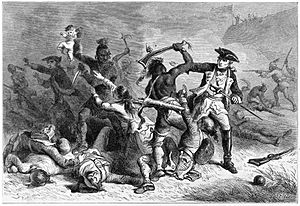
The next year, Montcalm had another big success at Fort William Henry. Vaudreuil ordered him to march south and capture British bases. These were Fort William Henry and Fort Edward.
Montcalm led 6,200 soldiers and 1,800 Native Americans from Fort Carillon. They attacked Fort William Henry on August 3, 1757. The fort was surrounded for three days before it surrendered. The surrender terms said the British soldiers would be escorted to Fort Edward. They could not fight the French for 18 months. All British prisoners would be returned to the French.
However, as the British soldiers left Fort William Henry, Montcalm's Native American allies attacked them. About 200 of the 2,000 prisoners were killed. This broke the surrender agreement. Montcalm decided not to attack Fort Edward, even though the British were weak. He said the road was too bad for his cannons. This decision made Vaudreuil very angry, making their relationship even worse.
Victory at Carillon
In July 1758, Vaudreuil sent Montcalm to stop a British attack near Fort Carillon. The British force was much larger than expected. It had 6,000 British soldiers and 9,000 local militiamen. On July 5, the British began their attack. But the death of their second-in-command slowed them down. This gave Canadian reinforcements time to arrive. Montcalm's total force grew to over 3,600 men.
Despite being outnumbered, the French held the fort. This was due to mistakes made by the British general, James Abercrombie. He did not wait for his heavy cannons to break the weak wooden defenses. He also failed to use a major weakness in the French lines. This would have allowed his troops to easily surround the French. Instead, the French kept firing their muskets and held off the attack.
This battle was a big win for the French and a major loss for the British. It greatly improved Montcalm's reputation. He often exaggerated his victories in letters to France. He also criticized the efforts of the Canadian and Native American fighters. Montcalm even accused Vaudreuil of trying to send his troops into a trap. Vaudreuil denied this and asked for Montcalm to be sent back to France. He wanted Chevalier de Lévis to take his place.
The Battle for Quebec
In late 1758, the British started to gain the upper hand in North America. They had many more resources than the French. France also sent very few supplies to its colony. New France was already facing starvation after a bad harvest.
So, King Louis XV ordered the colony to shrink its defenses. They had to give up forts in Ohio and around Lake Ontario and Lake Champlain. The French Minister of War still supported Montcalm. He believed Montcalm could still stop the enemy, like he did at Fort Carillon. This news, along with the threat of a British attack, made Montcalm lose hope. He felt he could not hold Quebec City if it was besieged.
Wolfe's British forces reached Quebec in late June 1759. They set up on the opposite shore and began bombarding the city on July 12. They shelled the city for two months, turning it into rubble. Montcalm managed to stop British landing attempts many times. The most notable was at the Battle of Beauport on July 31, 1759.
After a month of destroying the countryside, the British tried another landing on September 13. This time, they landed at l'Anse au Foulons. The French were caught by surprise. Before Montcalm could react, Wolfe's forces were already on the Plains of Abraham outside the city, ready for battle.
Montcalm made a decision that many see as his biggest mistake. He decided to attack the British with the troops he had. He did not wait for more soldiers from other parts of the city to join him. Montcalm believed that if he let the British build up their position, he would not be able to defeat them. So, he felt the attack had to happen right away. In the battle that followed, the Battle of the Plains of Abraham, the French forces were defeated.
Montcalm's Death and Burial
While riding back to Quebec City, General Montcalm was shot in the back. Three soldiers helped him get back to the city. A surgeon told him he would not live through the night. That afternoon, Montcalm used his last bit of strength. He signed his final official order as commander of the French army in Canada. He wrote a letter to General Wolfe, trying to surrender the city. He didn't know that Wolfe had also been killed in the battle.
Montcalm died around 5:00 AM on September 14, 1759. At 8:00 AM, he was buried in a shell hole under the church choir. On October 11, 2001, Montcalm's remains were moved. They were placed in a new mausoleum at the cemetery of the Hôpital-Général de Québec.
Montcalm and Vaudreuil: A Difficult Relationship
Montcalm's time in New France was marked by arguments with the Governor General, Pierre de Rigaud, Marquis de Vaudreuil-Cavagnial. There were two main reasons for their disagreements.
Different Military Backgrounds
First, Montcalm and Vaudreuil came from different parts of the military. Montcalm was an army soldier (troupes de terres). Vaudreuil was a marine officer (compagnies franches de la marine). This meant they reported to different government departments in France. Montcalm reported to the Ministry of War, and Vaudreuil to the Naval Ministry.
These different backgrounds led to competition. Each man wanted to protect his own power and influence. Montcalm often wrote to the Minister of War. He complained that Vaudreuil was not a good military planner. He hoped to replace him. Vaudreuil, in turn, wrote to the Naval Minister. He complained about Montcalm not following orders. The king had made Montcalm follow Vaudreuil's orders to avoid problems. So, their first source of conflict was very personal.
Different Ways of Fighting
Second, Montcalm and Vaudreuil had different ideas about how to fight the war. Montcalm represented the style of French officers from Europe. He believed the war should be fought like European wars. This meant using "planned campaigns, armies, artillery, sieges, battles." He thought this would protect France's military honor.
Vaudreuil, on the other hand, represented the style of Canadian colonial officers. He believed in "colonial methods." This meant building strong forts, defending the borders step by step, fighting defensively, and doing many raids. Most importantly, he relied heavily on Native American allies. Montcalm often criticized using Native American methods. He thought they were too cruel and would harm French honor.
The arguments between Montcalm and Vaudreuil mostly ended in 1758. Montcalm was promoted to lieutenant general. This meant he outranked Vaudreuil. He then had almost complete control over military plans.
Honors and Legacy
Four ships of the French Navy have been named in Montcalm's honor:
- An ironclad ship (1865–1891)
- An armored cruiser (1898–1926)
- A La Galissonnière-class cruiser (1933–1969)
- An F70 type frigate (1975–2017)
- The Montcalm Squadron of cadets at the Royal Military College of Canada was also named after him.
Many places and landmarks have been named to honor Montcalm. These include:
- Palais Montcalm, Quebec City, Quebec
- Rue Montcalm, Montreal, Quebec
- Montcalm Avenue, Plattsburgh, New York
- Montcalm, New Hampshire
- Montcalm Secondary School, London, Ontario
- Streets named Rue Montcalm in Paris, Caen, Clermont-Ferrand, and La Rochelle, France
- Rue Montcalm (Montcalm Street), Hull, Quebec
- Montcalm Crescent, Calgary, Alberta
- Montcalm Street, Detroit, Michigan
- Montcalm Avenue, St. Catharines, Ontario
- Montcalm Street, Vancouver, British Columbia
- Montcalm Street, Ottawa, Ontario
- Montcalm Street, Ticonderoga, New York
- Montcalm Avenue, Buffalo, New York
- Montcalm Park, in Oswego, New York
- Montcalm High School, Montcalm, West Virginia
- Montcalm Avenue, Brighton, Massachusetts
- Lake Montcalm, Montcalm County, Michigan
- Montcalm County in western Michigan
- Montcalm Close, Orewa, Auckland, New Zealand
- Montcalm Avenue, Baie-Comeau, Quebec
- Montcalm Road, Warfield, British Columbia
- Montcalm Street, Lake George (village), New York
- Montcalm Road, Charlton, London, England
- Rue Montcalm, Montpellier, France
See also
 In Spanish: Louis-Joseph de Montcalm para niños
In Spanish: Louis-Joseph de Montcalm para niños
- Military of New France
- French colonization of the Americas


